Eduard 1/48 Wildcat V
The Aircraft:
The FM-1 Wildcat was an F4F-4, redesigned to have armament of 4 .50-caliber weapons with the per-gun ammunition load of the F4F-3. It was produced by Eastern Aircraft, a division of General Motors, with production beginning in late 1942 and ending in mid-1943 when production switched to the FM-2 Wildcat.
The FM-1 served in the Fleet Air Arm as the Martlet V, the name changed in January 1944 to Wildcat V when all US aircraft in FAA service changed to their US name.
Wildcat V JV579, in service as “F” of 846 Squdron, FAA, named “That Old Thing”, is probably one of the better known Wildcats in FAA service, since a photo of it wearing D-Day identification stripes has been widely shown ever since the war.
The Wildcat, then known as a Martlet V, was originally delivered to 1832 Squadron, based at RNAS Eglinton, aka “HMS Gannet”, located in Northern Ireland. The Wildcats of 1832 Squadron were transferred to 846 Squadron, a “composite” squadron of Wildcats and Avengers aboard HMS Tracker.
HMS Tracker began her life as CVE-6, the sixth “Bogue” class CVE converted from a C-3 merchantman hull in 1942. She was transferred upon completion to the Royal Navy in November 1942 and arrived in Belfast, Northern Ireland, in March 1943 after delivering aircraft from Norfolk Virginia to Casablanca, Morocco. Over the rest of 1943 and early 1944 she sailed as an anti-submarine convoy escort.
On January 4, 1944 846 squadron embarked from RNAS Machrihanish. The new squadron was equipped with 12 Avenger II torpedo bombers and four Wildcat V fighters formerly of 'B' flight, 1832 Squadron. Among the Wildcats was JV579.
During the work up period there were four flying accidents, two involving Avengers, and two Wildcats; the first was on January 7 when Lt. J. E. Scott RNVR, crashed on deck landing in Wildcat JV333. The second incident was fatal: on January 10 Avenger FN828 crashed into the sea after its starboard wing came off while making practice glide bombing attack on the ship, possibly due to exceeding the maximum speed limitations; pilot Sub-Lt G. A. Houghton RNVR, observer Sub-Lt E. B. Dixon RNVR, and gunner Leading Airman R. F. Gates, and a passenger Ordinary Seaman G. A. Smith were killed in the crash. On the January 13 Lt G. W. McCabe RNVR in Wildcat JV348 landed with his arrester hook up and entered the barrier. An unidentified Avenger crashed on take-off on January 20; the aircraft veered into the port catwalk and its engine broke away from its mounts; the aircraft went overboard and pilot Sub-Lt S. J. Martin RNVR and two crew were safely picked up by the plane-guard destroyer.
After working up with the new squadron Tracker was assigned to on anti-submarine sweeps on the Gibraltar convoy route west of Cape Finisterre in February,working with HMS Biter as Air Group A.2 with one assigned to one anti-submarine and one a fighter carrier supporting Ocean Escort Groups.
Convoys ONS.29 and OS.68/KMS.42 departed Liverpool on February 12; ONS.29 for Halifax and OS.68/KMS.42 for Freetown/Gibraltar. Biter and Tracker initially supported ONS.29 while on passage to their rendezvous with the escort groups for the combined Freetown/Gibraltar convoy. The wind dropped on February 18 and the convoy was becalmed in the Bay of Biscay,famous for its atrocious weather conditions.
On February 23, OS.68 with 29 vessels continued on to Freetown, KMS42G with 27 ships arrived at Gibraltar on February 25. The escort group spent a week at Gibraltar. 846 Squadron flew ashore to RN Air Section North Front, re-embarking on March 2 when Tracker sailed to meet the next convoy.
Biter and T5racker supported Convoy SL150/MKS41 which formed at sea off Gibraltar on March 3 when Freetown-UK convoy SL.150 rendezvoused with MKS41, Gibraltar-UK. Flying was again hampered by a lack of wind. SL150/MKS41 was attacked on March 10 by U-575 which sank the Flower Class Corvette HMS Asphodel. Four of Tracker's Avengers searched for the U-boat but no trace was found.
Biter and Tracker arrived in Clyde on March 12th. After a one week leave, Tracker joined HMS Activity with 819 Squadron, three Swordfish and seven Wildcats, to escort Convoy JW58, leaving Loch Wew to Murmansk On March 27, 1944. On March 30, two Wildcats from Activity intercepted and shot down a Ju-88. The next day the Fw-200 Condors were intercepted and shot down. 846's Sub-Lt R. H. Meed RNVR in JV490and Sub-Lt G. C. Debney in JV485 of 819 Squadron shot down one Fw-200 while 846's Sub-Lt Swift in JV522 shot down the second and the third was shot down by an 819 pilot.
On April 1 a serious accident occurred aboard Tracker when an Avenger sighted and attacked a U-boat, but was unable to drop its depth charges. The pilot was able to drop three of the four while returning to the ship. Despite frantic signals to "go around again" from the Batsman, the pilot flew straight into the round down, at full throttle. The aircraft ended up with its tail hanging over the stern, balanced with the port wing on the stern Bofors mounting. The Avenger caught fire; the crew got out but the pilot was badly burned and died being taken to sick bay. A serious fire burned on the aft of the flight deck. The fire grew and ammunition in the Avenger and the Bofors mount ready use locker popped and exploded. Fire crews and damage control parties put the fire out in 15 minutes. Later that day another pair of Wildcats from each squadron claimed a Bv-138 seaplane shot down in flames.
846 Squadron lost two more Wildcats on April 2; one in a barrier crash, the other ditched when Sub-Lt T. D. Lucey, RNVR made a strafing attack on a surfaced U-Boat came in too low, striking the conning tower. He was rescued after 1 hour 55 minutes in the freezing waters.
On April 3 an 819 Squadron Swordfish spotted another U-Boat. The Swordfish came under heavy AA fire and was joined by Avenger FN869, flown by Lt J. S. Toner RNVR, Lt R. A. Woodward RNVR, and Wildcat JV512 flown by Sub-Lt G.W. McCabe RNVR of 846 Squadron. Combined depth charge attacks by the Avenger and rocket attacks by the Swordfish with strafing by the Wildcat resulted in the sinking of U-288 in the Barents Sea southeast of Bear Island.
Convoy JW59 reached Vaenga Bay without loss on April 4. Activity and Tracker covered return convoy RA58 which sailed on April 7. The convoy arrived at Loch Wew on April 12 and was detached to Belfast, arriving on April 14 to enter Harland & Wolf's dockyard for repairs to her fire damage.
Returning to duty on April 29, Tracker suffered storm damage in the Western Approaches and spent the first part of May in the Floating Dock at Greenock.
On June 3, 1944, Tracker left Greenock carrying 12 Avengers and 8 Wildcats of 846 Squadron; 'L' Flight of 1832 Squadron having been transferred on May 13. On June 5, all hands were employed to paint all the aircraft with the black and white recognition stripes for the invasion.
Tracker joined CVEs Pursuer and Emperor for operations in the western approaches as part of the cover forces for operation Neptune, operating in a position 150 miles west of Lands' End to carry out anti-submarine patrols to intercept U-Boat attempting to enter the English Channel.
On the night of June 10, Tracker and the Canadian frigate HMCS Teme collided in the dark when Teme was chasing down a U-boat contact and swept clean across Tracker's bow at 0200 hours. Tracker rammed Teme amidships and the two ships were entangled as the heavy swell pushed TRACKER forwards in a 'sawing' motion as if she was going to cut Teme in two. When eventually separated Teme had a gaping hole and was taken in tow by HMCS Outremont back to the UK.
Tracker was able to maintain her station despite her stove-in bow; the next day she catapulted all 21 aircraft over 40 minutes; Tracker arrived in Belfast on June 12 where the damage inspection indicated the need for a refit.
846 Squadron was decommissioned on June 12 and Wildcat JV579 was transferred to a training unit.
The Kit:
Eduard has yet to release an FM-1. However, the modification of an F4F-4 kit is easy, and that is what I proceeded to do.(Note: the Eduard FM-1 is now out; reviewers comment it is superior to the Tamiya late attempt to modernize their Wildcat)
Construction:
The gun bay doors on the wing are slightly raised - not enough to be seen with the naked eye, but you can feel it with your finger tip. I took a 1/4-inch wide sanding stick and removed the outer gun bay doors on the upper and lower surfaces without harming the surrounding surface detail. I sanded the area smooth and then used my pounce wheel to create riveting over the area. The whole process for both wings took about 30 minutes. Once the area was riveted, there was no sign of the previous detail.
Past that, the kit was assembled per the instructions. I painted all the interior parts and areas before assembly. FM-1s had the cockpit in interior green, rather than the bronze green used by Grumman on wildcats. The wheel well and accessory section were painted light grey.
Painting:
I painted the areas where the D-Day stripes would be applied with Tamiya SF-1 Flat Black, then masked off the black stripes and airbrushed the white stripes, which I then masked off.
FM-1s produced by Eastern Aircraft were painted with US “equivalent colors”, with Sea Grey replacing Extra Dark Sea Grey, Olive Drab replacing Dark Slate Grey, and Sky Grey replacing Sky. I did this freehand, using Tamiya paints.
Decals:
I found the Aeromaster sheet 48-046 “US Aircraft in FAA Service” on eBay, and used the decals for JV579, the Wildcat V made famous by an air-to-air photo taken of the airplane in its full D-Day markings.
Final Assembly:
I attached the landing gear and prop, and positioned the canopy in the open position.
Overall:
This is a conversion that anyone who has done simple conversions can accomplish easily.
The Eduard Wildcats are “definitive” and the best Wildcat kits available in 1/48 scale.
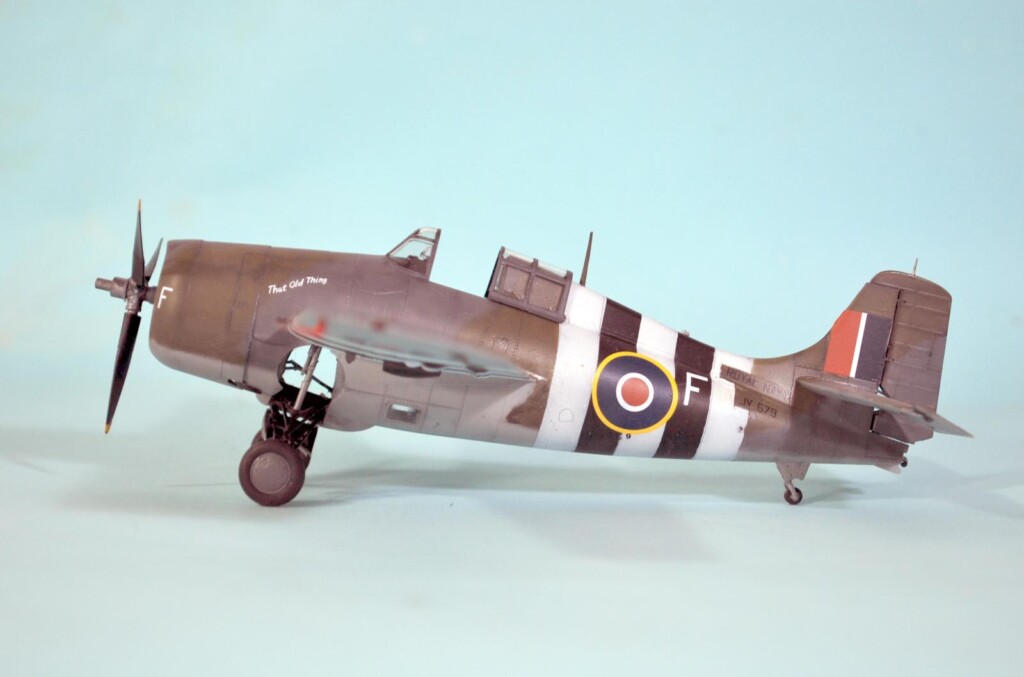
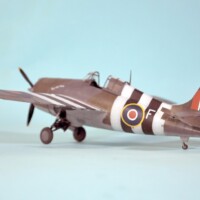
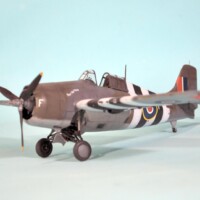
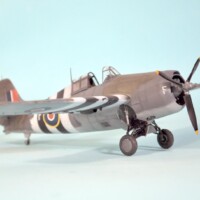
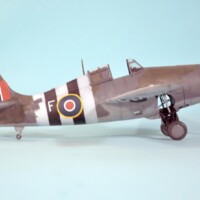
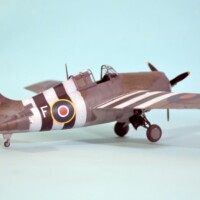
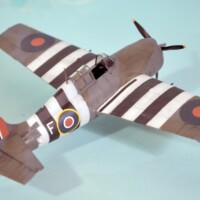
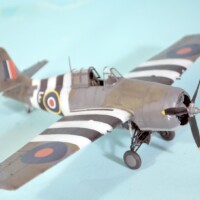
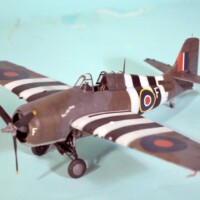
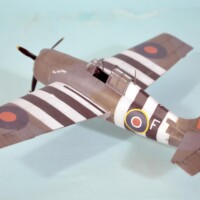
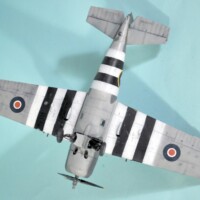
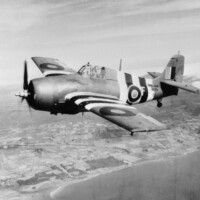
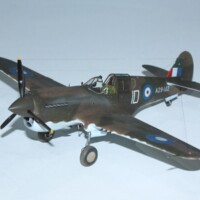
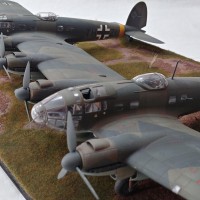
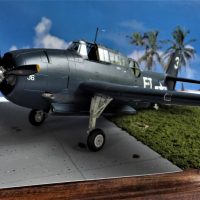
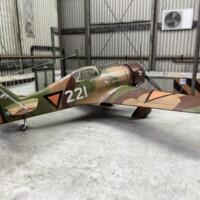
Awesome. Love the Wildcat in these colours.
This is a fine looking Wildcat, Tom @tcinla
It looks great in this British scheme.
Excellent supporting article as well.
Excellent result and ditto article, Tom!
Hey @fiveten - you doing okay with the floods and the fires?
We are all ok, my friend @tcinla. From one extremity to the other, though. Thanks for thinking of us.
Nice write-up and a lovely build.
Thanks for sharing.
I love Your paining and shading!
Excellent build and narrative Tom. Great looking Wildcat
Nice work Tom!
Nice work, Tom. Zero trace of the two lost guns.
A lovely build - I plan a brit-liveried Wildcat in the near future... nice to have this as a reference!
Nice - another inspiration!
Lovely looking Cat Tom , I like the "painted in the field " invasion stripes , I always do mine sharp and hard with masking tape even though I know it's not accurate , you got them spot on.
Great job .
Having sharp edges is OK even "in the field." Just paint the whole area black and then apply white over it, you'll get "distressed" easily.
Excellent build Tom.
Great looking Wildcat!
Terrific work, Tom (@tcinla). Nice modifications to get a British version. Well done.